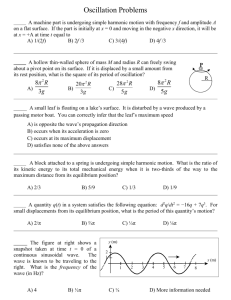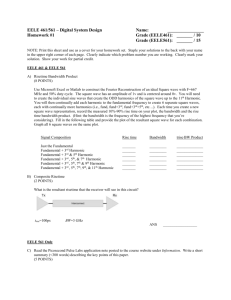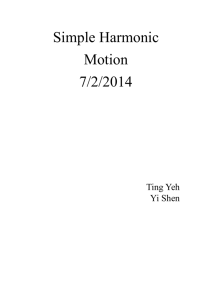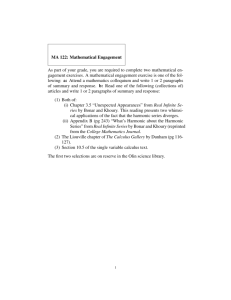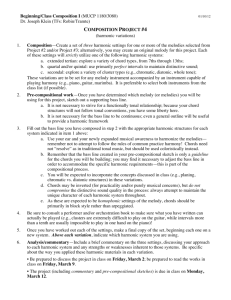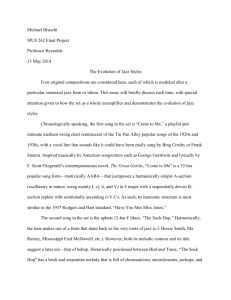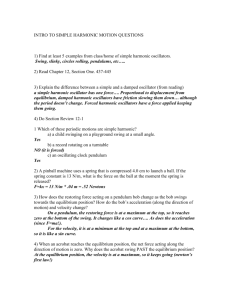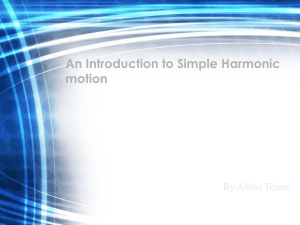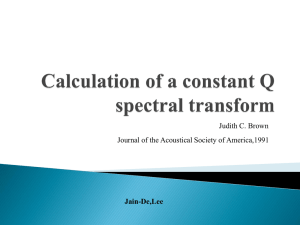A Grand Scientific Musical Theory
advertisement
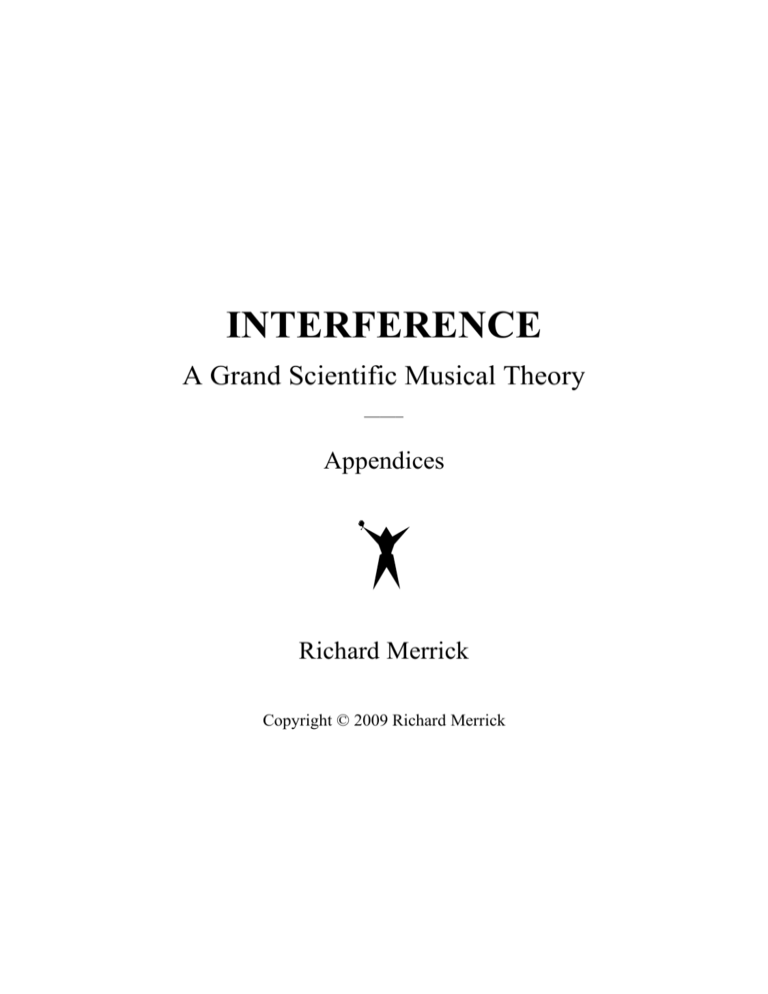
INTERFERENCE
A Grand Scientific Musical Theory
_____
Appendices
Richard Merrick
Copyright © 2009 Richard Merrick
2 APPENDIX
Appendix 1 : Glossary
Φ (pronounced either “Phee” or “Fi”) – an irrational and infinite number approximately equal to
1.61803 that occurs in nature as a convergent proportion of growth. Commonly known as the golden ratio,
this can be derived from the irrationality of the square root of five, or (1 + √5) / 2.
Chladni plate – a round or square metal plate sprinkled with sand or salt then vibrated to produce patterns
of specific musical tones and intervals. Name for physicist Ernst Chladni.
CMYK color space – a theoretical 4-dimensional space comprising the colors Cyan, Magenta, Yellow and
Black (“K” often taken as “kill”) that is capable of creating most of the colors in the visible light spectrum.
This is the method used in paint, color inkjet and offset printing to reflect full color images in magazines
and books. In general, CMYK is used to mix colors of reflected light by subtracting varying amounts of
these four colors, again often in increments of 256 steps for each color.
Coherence – the stabilizing property of wave-like states that enables formation of patterns. The most
coherent wave is a stationary standing wave producing simple whole number harmonics.
Coriolis Effect – named after Gaspard-Gustave Coriolis, a 19th century French scientist, is caused by the
Coriolis force which appears in the equation of motion of an object within a rotating frame of reference.
For instance, in the rotating reference frame of the Earth, moving objects veer to the right in the northern
hemisphere and left in the southern. The spin is accompanied by the formation of a double torus flow (like
stacked donuts) where each torus rotates in opposing directions while pulling material inward to a common
center, forming a disc of material spiralling in between. This idea is commonly taken within the theory of
torsion physics to explain an apparent orthogonal relationship between gravity and electromagnetism.
Cosine wave – a periodic trigonometric function representing oscillating energy at a right angle
(orthogonal) to a sine wave. The cosine wave is said to be in “phase-quadrature” with the sine wave.
Cycle of 5ths – a stack of twelve perfect 5th intervals (usually tuned equally) such that they form a closed
periodic series.
Damping – any effect, either deliberately engendered or inherent to a system, that tends to reduce the
amplitude of oscillations of an oscillatory system.
Diatonic scale – a group of seven tones that subdivide a musical octave, often used to refer to major or
minor scales.
Diatonic tritone – the one tritone interval possible in a diatonic scale. Also referred to here as the Inverse
Harmonic Axis.
Dodecahedron – one of the five perfect Platonic solids having twelve fully connected pentagonal faces.
Dodecaphonic – division of the octave into twelve equally spaced tones.
Dominant – the fifth tone above the Tonic corresponding to the third wave partial in the harmonic series.
Equal Temperament (also “12-ET”) – typically refers to the equal division of an octave into twelve equal
proportions of 21/12.
Fibonacci series – the set of numbers based on the addition of the preceding two numbers beginning with
{0, 1}. The series begins {0,1,1,2,3,5,8,13,21,34, etc.} and converges in a spiraling fashion toward Φ by
taking adjacent ratios {1, 2:1, 3:2, 5:3, 8:5, 13:8, 21:13, 34:21, etc.}.
First derivative (spatial) Gaussian distribution – the measurement of change in velocity across a
Gaussian distribution.
Fourier series – the trigonometric sine and cosine wave components that comprise the composite
waveform for a given sound. All sounds can be decomposed into their component sinusoidal waves, known
as Fourier analysis.
Gaussian distribution (also “normal distribution”) – a family of continuous probability distributions
used to describe natural periodic phenomena.
Golden ratio (also see Φ) – a natural mathematical proportion whereby a given length is subdivided so
that the total length is to the large segment as the large segment is to the small segment. As a percentage,
this is approximately 61% to 39% or a ratio of 1 : 0.618033 = 1.61803 – Φ. This is often approximated by
adjacent Fibonacci proportions.
Harmonic – a whole number multiple of a sound frequency.
Harmonic Axis – the tritone beginning on the SuperTonic, or second degree, of a diatonic scale.
Harmonic Center – refers simultaneously to the point of symmetry in a 7-step diatonic major/minor scale
and the first four octaves of the harmonic series. In an octave, this is commonly known as the SuperTonic
and in the harmonic seires as the ninth wave partial.
Harmonic series – the set of waves that are whole number multiples (2X, 3X, 4X…) of the fundamental
frequency. Occurs naturally in a standing wave of sound and elsewhere in nature.
4 APPENDIX
Inharmonicity (a.k.a. “stretch”) – the phenomenon of harmonics becoming sharper than their theoretical
proportion due to a vibrating medium (e.g., piano string) appearing stiffer to harmonics with shorter
wavelengths.
Holonomic (brain theory) – a lattice pattern of neurological wave interference established by
neurosurgeon Karl Pribram in the 1980s in partnership with British physicist David Bohm.
INTERFERENCE equation – alternate form of the standard Gaussian equation: y = n2 / (Φn) / √5)
Interval – distance between two musical tones in pitch space.
Key – In common practice, the persistent use of a diatonic scale in a piece of music.
Landau damping – a theory about how waves exchange energy as they cross (or nearly cross) that results
in a net loss of energy in the wave system.
Lattice – a regular grid structure, typically diagonal or rectilinear.
Lucas series – the set of number based on the addition of the preceding two numbers beginning with {2,
1}. The series begins {2, 1, 3, 4, 7, 11, 18, 29, etc.} and converges in a spiraling fashion toward Φ (like the
Fibonacci series) by taking adjacent ratios.
Phase-quadrature – a 90-degree or right angle phase shift between sine and cosine waves.
Pythagorean comma – the gap between a stack of twelve perfect 5ths and seven octaves, approximately
equal to 1.01364326
RECURSIVE CHROMATIC DUAL RING – A three-level cursive application of the Chromatic Dual
Ring that emulates the cubic damping proportions of the Mandelbrot Set. After the first Chromatic Dual
Ring, each subsequent Chromatic Dual Ring set is positioned with its center in alignment with a common
Harmonic Axis and tangent to the outermost ring of the previous. This enables measurement of harmonic
proportions within each recursive level of the Mandelbrot Set.
REFLECTIVE INTEGRAL equation set – the REFLECTIVE INTERFERENCE set added together.
RECURSIVE INTERFERENCE MATRIX – A twelve-level recursive hierarchy of phi-proportioned
rings and orthogonally aligned harmonic waves capable of containing the archetype of any organic object.
REFLECTIVE INTERFERENCE equation set – the INTERFERENCE equation reflected about the
midpoint of an octave.
Resonance – the tendency of a system to oscillate at maximum amplitude at a certain frequency.
RGB color space – a theoretical 3-dimensional space comprising the colors Red, Green and Blue that is
capable of creating all of the colors in the visible light spectrum. This is the method used in CRT television
monitors and other such direction projection devices to create full color images and video. In general, RGB
is used to mix colors in direct light by the addition of varying amounts of these three colors, often in
increments of 256 steps for each color.
Rosslyn “magic ratio” – the naturally resonant proportion 1:81, also 68:40.5, equal to
0.0123456790123455000000 or 1:34, found in the dimension of 15th century Rosslyn chapel in Scotland.
Sine wave – a periodic trigonometric function representing oscillating energy at a right angle (orthogonal)
to a cosine wave. Said to be “in-phase.”
Spectral analysis (in sound) – the pattern of interference produced by one or more wave frequencies.
Standing wave – the ability of a wave to oscillate in stationary position, thereby enabling sympathetic
harmonic waves to form.
Shepard Tones – an experiment that demonstrated the perceived circularity of pitch. Originally, this was
demonstrated using a series of ascending or descending octaves following a cycle of perfect 5th intervals
that were amplified using a Gaussian fade filter.
Temperament – a particular formula for subdividing and tuning tones in an octave, such as Pythagorean
temperament, Just temperament, Meantone temperament, Well-temperament and Equal Temperament.
Timbre – the characteristic sound of a musical instrument created by a specific set of harmonic sinusiodal
components.
Tonic – the starting tone of a diatonic scale corresponding to the fundamental or first partial of the
harmonic series.
Tritone – the interval of three wholetones. In 12-Equal Temperament, this is exact half of an octave.
Tritone Function – the oscillating movement between a tritone and circumscribed major 3rd that is the
primary driver of harmonic function in a diatonic major-minor key.
Wave partial – the fundamental or harmonic wave, usually referred to as a number in the order of natural
occurrence in a standing wave.
6 APPENDIX
Appendix 2 : The Social Interference Thesis
Hypothesis 1: The tetrachord genera were a Pythagorean “mending function” for a musical
octave, joining the Spiral of 5ths and octave cycle into a pentagram at two octave golden ratio
proportions inside what is today known as the Tritone Function.
Hypothesis 2: The negative reputation of the tritone interval in music history is due to its
association with the pentagram and its contained golden ratio, thought to reveal an error in nature
and, thus, in mankind as “original sin.”
Hypothesis 3: The Medieval Catholic Church banned the tritone in the early 13th century due to
its association with Pythagoreanism and other Hermetic/ Kabbalistic philosophies.
Hypothesis 4: The development of the 12-step octave and simplified system of major-minor
diatonic scales resulted from the replacement of a Pythagorean pentagonal design with that of an
equilateral triangular design.
Hypothesis 5: The Inquisition created a complicity of convenience in the 17th century between
Western religion and science that resulted in the separation of harmonic science from natural
science. This resulted in the formation of history, philosophy and music as a humanities track
well insulated from the scientific method.
Hypothesis 6: Johannes Sebastian Bach was the leading proponent of the Tritone Function and
popularized its use thereafter.
Hypothesis 7: A wholetone scale is a generalization of a tritone – thus, chromatic harmony can
be seen as two oscillating wholetone scales derived from the generalization of the Tritone
Function.
Hypothesis 8: The conventions of diatonic harmony based on major and (“relative”) minor scales
are founded on the recognition of symmetry around a shared SuperTonic centered in the middle
of the Tritone Function.
Hypothesis 9: Modern music theory is based on the rules and conventions of asymmetry
inherited from the tritone avoidance laws of the Medieval Catholic Church.
Appendix 3 : Principles of Harmonic Interference
Principle 1: People interpret the pitch spectrum as a vertically geometric pitch space that is both circular
and symmetric.
Principle 2: People interpret circularity in the frequency doubling at the octave.
Principle 3: People interpret tones in an interval having a tendency or tension to move up or down based
on whether it is less than or greater than a half octave or tritone. The tritone itself is perceived as an
ambiguous inflection point between opposing directions, producing what is popularly known as the Tritone
Paradox.
Principle 4: People interpret movement between tones as motion between locations in pitch space,
analogous to the perception of spatial location and motion of objects in visual space.
Principle 5: People interpret pitch space in hierarchical groupings that are recognized as auditory
geometry. Furthermore, within this hierarchy exists a “half twist” reflective symmetry.
Principle 6: The distribution of wave interference in the harmonic series is described by a ratio between the
square of the harmonic series and the Fibonacci series, otherwise referred to as the INTERFERENCE
resonance function:
y = 1 / (Φ/√5), 4 / (Φ2/√5), 9 / (Φ3/√5), …, n2 / (Φn/√5)
y = n^2 / (Φ^n / √5) , n = {1..12}
Principle 7: The 12-step octave follows the natural distribution of harmonic interference that reaches an
octave harmony at √144 = 12 and anti-harmonic center at √12.
Principle 8: Harmonic tension can be measured as a function of the REFLECTIVE INTERFERENCE
pattern. Taking each of the amplitudes as a percentage of maximum resonance from the Leading Tones, we
have the following order of tension (greatest to least) in a diatonic scale:
Diatonic Scale
C Major Scale
Percent
Leading Tone, Inverse Leading Tone
{B, F}
100%
Tonic, Inverse Tonic
{C, E}
97%
Harmonic Center
{D}
72%
Dominant, Inverse Dominant
{G, A}
66%
8 APPENDIX
Principle 9: Interval consonance can be measured as a function of the INTEGRAL INTERFERENCE
pattern. Taking each of the amplitudes as a percentage of maximum consonance from the octave, we have
the following order of consonance (greatest to least):
Interval
Inverse Harmonic Center
Percent
Octave
{G#, G#}
100%
P4, P5
{C#, D#}
54%
M3, m6
{C, E}
39%
m3, M6
{B, F}
34%
M2, m7
{A#, F#}
32%
m2, M7
{A, G}
31%
Tritone
{D, G#}
31%
Principle 10: The Principle of Tritone Duality is the ability to perceive intervals as either consonantdissonant or tense-resolved depending on context. During the recognition process, an interval can either be
1) measured spatially as an integral function to produce the sensation of consonance or 2) measured
temporally as a differential function to produce the sensation of tension. The choice between the two is
apparently determined by the degree of diatonic harmonic movement afforded in the context of the music.
Principle 11: The Fibonacci series converging to the golden ratio and its inverse ratio acts as natural Φdamping proportions within the harmonic series to prevent the formation of destructive fractional wave
partials.
Principle 12: The Landau damping principle in plasma waves provides a physical model for energy
transfer between harmonic wave partials in a sonic standing wave. Our auditory system appears to judge
interval consonance and dissonance based on the gain or loss of energy in corresponding harmonic partials.
We also appear to recognize the directional energy flow between wave partials in the harmonic series as
tension and resolution, creating a cognitive anticipation/reward potential for tones to move toward and
across Φ-damping zones. The degrees of consonance and tension are represented as amplitude, or change in
velocity, on the REFLECTIVE INTERFERENCE distribution model.
Principle 13: The Fibonacci series, converging to the golden ratio Φ, acts as a natural damping proportion
within the harmonic interference pattern of an octave to prevent fractional wave partials from forming
while enabling standing wave harmonics to resonate. Maximum resonance and damping locations within
the harmonic series or octave may be estimated to four decimal places using these equations:
Max Resonance Ratio = Φ + (7 / 122) = 1.6666 ≈ major 6th = 5:3 ratio
Max Damping Ratio = (5 / 3) – (7 / 122) = 1.618 ≈ Φ ratio
A small “slack” or “free space” area of 0.006966 ≈ 0.007 exists between maximum resonance and
maximum damping, equaling a ratio slightly less than 1:144 of an octave. Doubling this free space as a
“halo” around these locations defines an effective “field of influence” in the proportional octave region
0.01393333 ≈ 0.014 < 0.0144 = 0.122.
Principle 14: Harmonic Partial 9, corresponding to the SuperTonic, is fully π-symmetric and Φ-damped
relative to the fundamental (Tonic). This tone-to-octave relation is given the label of Harmonic Center as a
special point of balance in the harmonic series.
Principle 15: The greater the wave symmetry in Φ-damping, particularly when weighted toward the out-ofphase cosine component, the greater is the perceived timbral dissonance. No damping alignment indicates
maximum timbral consonance. In general, harmonics above the thirteenth partial are increasingly damped
due to shorter wavelengths that bring them ever nearer to damping locations.
Principle 16: The Timbral Consonance Principle is the ranking of standing wave partials and their
corresponding music intervals based on harmonic Φ-damping and Φ-alignment attributes. Following the
order from non-damped to even to mostly odd-damped, we can rank intervals from most consonant to most
dissonant:
Interval
Harmonic Φ-damping Attribute
1.
major 6th
minor 3rd
Not Φ-damped
2.
minor 6th
major 3rd
Not Φ-damped
3.
perfect 5th
perfect 4th
Even Φ-damped
4.
minor 7th
Odd Φ-damped
5.
major 2nd
Odd/ Even Φ-damped
6.
major 7th
Near Odd/ Even Φ-damped and Odd Φ-symmetric
7.
minor 2nd
Near Odd/ Even Φ-damped and Odd Φ-symmetric
Principle 17: The greater the wave symmetry in π-alignment, particularly when weighted toward the inphase sine component, the greater is the perceived harmonic resolution. In general, partials above the
thirteenth partial are non-aligned, making them seem harmonically unresolved to the ear.
Principle 18: The Timbral Tension Principle is the ranking of standing wave partials and their
corresponding diatonic music intervals based on π-alignment and π-symmetry about Partial 9 (the
Harmonic Center or SuperTonic). Following the order of even to odd to symmetric alignment, the
corresponding diatonic scale steps are ranked from most tense to most resolved:
10 A P P E N D I X
Scale Step
Harmonic π-symmetry Attribute
1.
Leading Tone (major 7th)
Even π-aligned
2.
Dominant (perfect 5th)
Odd π-aligned
3.
Subdominant (perfect 4th)
Odd π-aligned
4.
Augmented 6th (minor 7th)
Odd π-symmetric
5.
Mediant (major 3rd)
Odd π-symmetric
6.
Submediant (major 6th)
Odd / Even π-symmetric
7.
SuperTonic (major 2nd)
Odd / Even π-aligned and fully symmetric
8.
Tonic (unison)
Odd / Even π-aligned and fully symmetric
Principle 19: The Timbre/ Harmony Equivalence Principle holds that instrument timbre and music
harmony are the exact same cognitive recognition process occurring at different levels in a hierarchy of
harmonic interference. Intervals and chords simply amplify corresponding harmonic partials to strengthen
the effect of the underlying harmonic interplay occurring in a standing wave of sound.
Principle 20: Within the calm Landau parameter space between neighboring amplitude and frequency Φdamping locations, wave partials transfer energy as a phase/frequency modulation. This is perceived as an
auditory sensation of temporal movement in the direction of energy flow. Within a standing wave and
interference pattern of tonality, energy exchange produces an “anticipation/reward potential” in the
progression of melodies, intervals and chords in music harmony.
Principle 21: The Harmonic Hierarchy is defined as an equivalence class of 5 identical levels of harmonic
interference that is generated from a single tone, aligning at different resolutions over pitch space:
TwelfthTone =
2^(2/ 3456) = 2^(12^-3)
2^(12^-2)/12
1.000401207
Tone =
(TwelfthTone)^12
2^(12^-1)/12
1.004825126
Semitone =
(Tone)^12
2^(12^0)/12
1.059463094
Octave =
(Semitone)^12
2^(12^1)/12
2
TwelfthOctave =
(Octave)^12
2^(12^2)/12
4096
which may be represented as the recursive exponential functions:
4096 = TwelfthOctave (Octave ( Semitone ( Tone ( 2^(2/3456) )^12 )^12 )^12 )^12
2^(2/3456) = TwelfthTone (Tone ( Semitone ( Octave ( 4096 )^(1/12) )^(1/12) )^(1/12) )^(1/12)
or as a finite power series of 2 beginning with n = -2:
f(n) = 2^(12^n)/12 , n={-2..2}
These five layers act as a harmonic projection screen from which the musical geometry of melody, intervals
and chords can emerge. Any property found at one level of this hierarchy will apply at all levels.
Principle 22: The equal temperament system, based on the multiplied semitone ratio of 2^(1/12), is a
natural proportion within the recursive structure of the harmonic series generated by a standing wave.
Therefore, contrary to any argument that equal temperament is man-made, it is the one true natural tuning.
Principle 23: The cognition of music harmony is defined by the proportional interference of wave
resonance and Φ-damping in the natural harmonic series following the hierarchy of 2^(12^n)/12.
Specifically, the proportions recognized in the standing wave interference pattern of a single tone are the
same across the hierarchy of a semitone, octave and 12-octave frequency spectrum. In this way, the
cognitive spatial and temporal qualities of timbre, harmony and spectra form a cognitive equivalence class.
Principle 24: The development of the 12-step octave originates in the natural recognition of the tritone
interference pattern of Partials 5 and 7 against the fundamental.
Principle 25: The organizing property of the golden ratio is the central cognitive principle of music
harmony.
Principle 26: The Fibonacci Series acts as a vortex-like temporal damping function at each level of the
auditory hierarchy of 2^(12^n)/12. This is the cognitive “gravity” of music harmony.
Principle 27: The oscillating ratios of the Fibonacci series represent increasingly calm areas within an
octave and semitone where energy may be exchanged between harmonic wave partials. Common practice
music theory and preferred voice leading was a direct result of a natural cognitive awareness of this energy
transfer.
Principle 28: Common practice use of the tritone and Tritone Function in music harmony follows the
oscillating behavior of the Fibonacci Series as it temporally damps any harmonic standing wave. The
universality of this principle in Western history suggests the human brain is itself organized like a standing
wave.
Principle 29: Anticipation-reward potential in music harmony can be measured using Partial 5 as a
“coherent pathway” through the interference pattern of the harmonic series. This pathway is hypothesized
to be recognizable by the auditory system in two concurrent and opposing phase states of oscillation either
side of the Harmonic Center. At the octave level of the interference pattern, the “cognitive cue” for which
phase to recognize can be defined by which member of the Tritone Function is in play and its oscillation
state. The phase indicators around the Harmonic Center are:
Diatonic Phase 1 = tritone = {up, down}
Diatonic Phase 2 = major 3rd = {down, up}
The auditory system may then measure and anticipate the potential direction of movement as an averaged
direction in each half octave around the Harmonic Center, ideally using the Diatonic Phase indicators as
12 A P P E N D I X
cues. This principle applies over time within a memory context to predict melodic direction and overall
musical momentum.
In the most general form, anticipation-reward potential follows the oscillation and energy exchange in a
standing wave.
Principle 30: Any temperament (tuning method) that provides exclusivity and cyclic closure in pitch space
enables the recognition of harmonic shape to some degree against the proportions of the harmonic series.
Principle 31: Music cognition results from the pattern matching of auditory shapes against the same
harmonic shapes evolved into the structure of the inner ear and auditory cortex. The degree to which
auditory shapes can be recognized and predicted is defined by how closely the musical scale conforms to a
harmonic standing wave, especially following the energy transfer across Φ-damping locations.
Principle 32: The REFLECTIVE INTERFERENCE structure of the eardrum and Fibonacci action of the
basilar membrane of the inner ear is the essential coupling mechanism between the physics of sound and
the Brodmann Area in the auditory cortex of the brain. We can predict from this that the Brodmann Area
itself is also organized as a REFLECTIVE INTERFERENCE neural network.
Principle 33: Holonomic Music Cognition is defined as a spatiotemporal coherence pattern matching
operation as follows:
1. Sensory perception of music harmony begins as a neurological Fourier transform from spatial
frequency to spatial position and proportion.
2. Spatial coherence in sound is a cognitive pattern matching of harmonic proportions against fixed
proportions of the natural harmonic series within a range of tolerance.
3. Temporal coherence in sound is a cognitive pattern matching of melodies, intervals and chords
(following Partial 5 and the Fibonacci series as a coherent pathway) phase shifted and/or frequency
modulated against a fixed spatially coherent reference scale.
4. The proportions of the reference scale are instantly and economically recognized as neural pathways
(like Partial 5) in the auditory cortex.
Holonomic brain theory [Pribram (1991)] offers the best explanation for the cognitive functions required to
recognize the standing wave interference pattern produced by the natural harmonic series. From this, we
might also predict that the fundamental organizing principles of the brain will follow the INTERFERENCE
functions.
Principle 34: The best-fit Synesthetic Color Model matching the perceptual interference pattern of the
harmonic series maps color frequencies of common practice primary, secondary and tertiary colors onto the
12-step octave. The assignment proceeds clockwise as an ascending spectrum of frequency.
Diatonic Scale Step
Color Assignment
Color Group
Inverse Dominant (Submediant)
Yellow
Primary
Light Green
Tertiary
Leading Tone
Green
Secondary
Tonic
Light Blue (Cyan)
Tertiary
Blue
Primary
Indigo
Tertiary
Violet
Secondary
Inverse Tonic (Mediant)
Dark Red (Magenta)
Tertiary
Inverse Leading Tone (Subdominant)
Red
Primary
Red Orange
Tertiary
Dark Orange
Secondary
Orange
Tertiary
Harmonic Center
Dominant
14 A P P E N D I X
Appendix 4 : A preliminary axiomatic system for
harmonic models
Axiom 1: Transposition Tn and Inversion In operations for orbits under ℤ/12ℤ can be defined as:
If n, m ∈ ℤ/12ℤ such that n is the pitch to be transposed and m is the transposition interval, then:
[Tn = (n + m) mod 12]
[In = 12 – n]
Axiom 2: An initial set definition of affine orbits for cyclic ring ℤ/12ℤ can be defined as:
m2 / M7 Orbits:
[Tn, In : n, m = {0, 1, 2, 3, 4, 5, 6, 7, 8, 9, 10, 11}]
M2 / m7 Orbits:
[Tn, In : n, m = {0, 2, 4, 6, 8, 10}]
m3 / M6 Orbits:
[Tn, In : n = {0, 3, 6, 9}, m = {0, 1, 2}]
M3 / m6 Orbits:
[Tn, In : n = {0, 4, 8}, m = {0, 1, 2, 3}]
P5 / P4 Orbits:
[Tn, In : m, n = {0, 7, 2, 9, 4, 11, 6, 1, 8, 3, 10, 5}]
TT Orbits:
[Tn, In : n = {0, 6}, m = {0, 1, 2, 3, 4, 5}]
Major Scale Orbits:
[Tn : n = {0, 2, 4, 5, 6, 7, 11}, m = {0..11}]
Minor (Relative) Scale Orbits: [Tn : n = {0, 2, 3, 5, 7, 8, 10}, m = {0..11}]
Derivation of Axiom 3: oscillation of the Tritone Function
If n ∈ ℤ/12ℤ and z ∈ 2ℤ = {…,-6, -4, -2, 0, 2, 4, 6, …}, we can define a generalized oscillation function
ψ “Psi” between the dual wholetone scales over time using t ∈ N = {0, 1, 2, 3, …}:
ψtz = [Tn, In : n ∈ {0, 4}, m ∈ Z]
t+1
ψ
z+1
= [Tn, In : n ∈ {-1, 5}, m ∈ Z]
// Major 3rd = Even: 2ℤ
// Tritone = Odd: 2ℤ + 1
The Tritone Function can then be defined as an oscillating subset of ψ by pairing up members of the
tritone and major 3rd sets over time under the same transposition m. This produces the axiom:
Axiom 3: The Tritone Function is defined by the harmonic oscillation of orbits ψ ∈{-1, 0, 4 5} taken
from ℤ/12ℤ. This is represented by the dihedral relation {ψ
between 2ℤ (even) and 2ℤ+1 (odd) cycles.
t
2z
⋃ ψ t+12z+1} as it occurs over a time t and
As example, a cadence of the Tritone Function for the C major scale could be specified like this:
{ψ00 = T-1}, {ψ00 = T5}
{ψ00 = (-1 + 0) mod 12, {ψ00 = (5 + 0) mod 12}
{ψ00 = -1}, {ψ00 = 5}
// Tritone interval F – B at t = 0
{ψ 11 = T0}, {ψ11 = T4}
{ψ11 = (0 + 0) mod 12}, {ψ11 = (4 + 0) mod 12}
{ψ11 = 0}, {ψ11 = 4}
// Major 3rd interval C – E at t = 1
With respect to time T, we can then construct the oscillation sets for each clock tick t in harmonic
progression:
C Major Tritone Function Oscillation Set:
{ψ00 = {-1, 5} ⋃ ψ11 = {0, 4}}
And the union set of all members over time t:
C Major Tritone Function Union Set over Time:
{F, B, C, E}
Axiom 4: The Wholetone Function is a generalization of the Tritone Function to represent chromatic
harmony as the oscillation between the two wholetone scales:
WTtz = {ψt2z = {0, 2, 4, 6, 8, 10} ⋃ ψt+12z+1 = {1, 3, 5, 7, 9, 11}}
Axiom 5: The Dominant and Inverse Dominant Function is defined by the harmonic oscillation of orbits
{ψt0 = {5, 7, 9, 11} ⋃ ψt+11 = {0, 2, 4}} contained in the harmonic series as divided by ℤ/12ℤ. Cancellation
or resolution of oscillation occurs upon introduction of a union set of ψt+n = {0, 4, 7} of the major Tonic
triad or ψt+n = {9, 0, 4} of the minor Inverse Tonic triad. Other resolving set intersections are possible,
though resulting in lesser degrees of standing wave cancellation and cognitive resolution.
Axiom 6: The Diatonic Cycle of 5ths is defined as a symmetrical movement across the harmonic series
following a path of alternating downward perfect 5th phase modulations between sine (odd Tonic) and
cosine (even Dominant/ Inverse Dominant) components. This is defined as a harmonic oscillation of oddeven orbits {ψt0 = {0, 4, 2} ⋃ ψt+11 = {{5, 11}, 9, 7} contained in the harmonic series as divided by ℤ/12ℤ.
Note that tritone orbit {5, 11} acts as an equivalence class within the oscillation set.
16 A P P E N D I X
Axiom 7: A 7-step Diatonic Key is defined by a perfect 5th/ 4th axis of symmetry between the Tonic sine
and Dominant/ Inverse Dominant cosine groups, phase shifted with a reverse “half twist” of 180 degrees
within a standing wave interference pattern. For a given Harmonic Axis, a diatonic key is represented by
the orbits ψt0 = {{0, 2, 4} ⋃ ψt+11 = {{5, 11}, {7, 9}} contained in the harmonic series described by ℤ/12ℤ.
Its complementary tritone substitute key is given by ψt0 = {6, 8, 10}} ⋃ ψt+11 = {{1, 3}, {5, 11}.
Axiom 8: A Simple Rule of Thumb for Chromatic Harmony: Any progression of scales, intervals or
chords that alternate one or more tones between the wholetone scales will create a sense of tension. The
sensation of resolution occurs when the oscillation is canceled with any interval that straddles the two
wholetone scales, such as a perfect 5th.
Axiom 9: A Simple Rule of Thumb for Diatonic Harmony: Under Axiom 8, incorporate the Tritone
Function and/or Dominant (or Inverse Dominant) cadences to strengthen recognition of a single Harmonic
Center and coherent pathway of the 7-step diatonic scale. Continued recognition of diatonic harmony is
then directly proportional to persistence of just one Harmonic Center.
Appendix 5 : 81-AET (Arithmetic Equal
Temperament)
The research into the harmonic dimensions of Rosslyn Chapel in Scotland, the proportion
1:81 = 0.012345679012345… was found to be a natural spacing constant in the “halo” of
resonance surrounding the interval of maximum resonance, the major 6th. This discovery led to
the formulation of a temperament system, referred to here as 81 Arithmetic Equal Temperament,
81-AET or simply “chapel temperament,” as a system of instrument tuning adapted to fit the
maximally resonant interior of Rosslyn Chapel.
This temperament divides the octave into 81 equal proportions from which twelve ratios
nearest to whole number proportions were selected. The result is a tuning system that is a
compromise between 12-ET and Just temperament. While similar to a few other temperament
systems, to my knowledge this is its publishing debut.
18 A P P E N D I X
Appendix 6 : Bibliography
Social Thesis
•
Bach-Leipzig.de, Bach-Archiv Leipzig
•
Bellingham, J. (2005): "Aurelian of Réôme,” Grove Music Online ed. L. Macy
•
Benward, B. (1977), “Music in Theory and Practice,” WM. C. Brown Company, ISBN 0-69703596-4, pp. 259 – 272
•
Butler, A., Ritchie, J., “Rosslyn Revealed: A Library in Stone,” O Books (October 2006), ISBN10: 1905047924, ISBN-13: 978-1905047925,.Soergel, P.M. (1993): “Wondrous in His Saints:
Counter Reformation Propaganda in Bavaria” Berkeley CA: University of California Press.
•
Comotti, G., (Original 1979), “Music in Greek and Roman Culture,” The Johns Hopkins
University Press, 1991, ISBN 080184341X
•
DeLone R.P. (1971), “Music Patterns and Style,” Addison Wesley Publishing Company, ISBN
78-100859, pp. 58.
•
Diels, H. and W. Kranz (1952), “Die Fragmente der Vorsokratiker” (in three volumes), 6th
edition, Dublin and Zürich: Weidmann, Volume 1, Chapter 14, 96-105.
•
Fr. Joncas, J.M. (1997), “Psalms, Hymns, and Spirtual Songs: Roman Catholic Liturgical Music in
the United States Since Vatican II,” University of St. Thomas, Immaculate Conception Seminary
School of Theology, theology.shu.edu/lectures/psalms.htm.
•
Frederick, C., “The Sun and the Serpent: A Contribution to the History of Serpent-worship,”
Asian Educational Services, ISBN-8120604164, 1988.
•
Fux, J.J. (1980), Article in The New Grove Dictionary of Music and Musicians, ed. Stanley Sadie.
20 vol. London, Macmillan Publishers Ltd., ISBN 1-56159-174-2
•
Fux, J.J. (1965), “The Study of Counterpoint (Gradus ad Parnassum).” Tr. Alfred Mann. New
York, W.W. Norton & Co., ISBN 0-393-00277-2
•
Gaines, J.R., “Evening in the Palace of Reason,” Fourth Estate (March 1, 2005), ISBN-10:
0007156580, ISBN-13: 978-0007156580.
•
Gutthrie, K.S. (1987), “The Pythagorean Sourcebook and Library: An Anthology of Ancient
Writings Which Relate to Pythagoras and Pythagorean Philosophy.”
•
Hanford, J., “The J.S. Bach Home Page” - JSBach.org,
•
Hindemith, P. (1949), “Elementary Training for Musicians,” Second Edition, B. Schott Sohne,
copyright renewed 1974, ISBN 0-901938-16-5, pp. 143 – 144
•
Hoppin, R.H. (1978), Medieval Music. New York, W.W. Norton & Co., ISBN 0393090906
•
Hutchison, F. (2006), “A cure for the educational crisis: Learn from the extraordinary educational
heritage of the West,” an article in RenewAmerica.
•
Kahn C.H. (2001), “Pythagoras and the Pythagoreans: A Brief History.”
•
Knud J. (Original 1931), “Counterpoint: The Polyphonic Vocal Style of the Sixteenth Century.”
New York, Dover Publications, 1992. ISBN 0-486-27036-X
•
Lester, J. (1994) “Too Marvelous for Words: The Life and Genius of Art Tatum,” Oxford
University Press, ISBN 0-19-509640-1
•
Levin, F.R. (1994), “The Manual of Harmonics of Nicomachus the Pythagorean,” Phanes Press,
ISBN 0-933999-42-9, pp. 76-139.
•
Livio, M. (2002), “The Golden ratio: The Story of Phi The World’s Most Astonishing Number,”
Random House, Inc., ISBN 0-7679-0816-3, pp. 183 – 187.
•
McKinnon, J. (1990), ed. “Antiquity and the Middle Ages” Englewood Cliffs, NJ: Prentice Hall
•
Monro, D.B., (2004), “The Modes of Ancient Greek Music,” Kessinger Publishing, ISBN
14179695603
•
O'Connor, J.J. and Robertson, E.F. "Leonardo Pisano Fibonacci – 1170 - 1250" in The MacTutor
History of Mathematics archive. University of St Andrews website, Scotland, 1998.
•
Palisca, C.V. (2005): "Guido of Arezzo,” Grove Music Online ed. L. Macy
•
Parrish, C. (1957), “The Notation of Medieval Music” London: Faber & Faber.
•
Prestini, E., “The Evolution of Applied Harmonic Analysis: Models of the Real World,”
Birkhauser, Boston,ISBN 0817841254, p. 16.
•
Reese, G. (1940) “Music in the Middle Ages” New York: W. W. Norton.
•
Rogers K.M, “L. Frank Baum, Creator of Oz: A Biography”, New York, St. Martin's Press, 2002;
p. 152.
•
Sadie, S (1980). "Tritone " in The New Grove Dictionary of Music and Musicians (1st ed.).
MacMillan, pp.154-155, ISBN 0-333-23111-2)
•
Seay, A. (1965), “Music in the Medieval World” Englewood Cliffs, NJ: Prentice Hall.
•
Symonds, J.A., “Studies of the Greek Poets.” American ed. New York: Harper.
•
The Catholic Encyclopedia, Volume VI. Published 1909. New York: Robert Appleton Company.
Nihil Obstat, September 1, 1909. Remy Lafort, Censor. Imprimatur. +John M. Farley, Archbishop
of New York
•
“The New Grove Dictionary of Music and Musicians,” ed. Stanley Sadie. 20 vol. London,
Macmillan Publishers Ltd., 1980. ISBN 1561591742
•
Wiener, P.P., “The Dictionary of the History of Ideas,” New York, NY: Charles Scribner’s Sons,
1973-74, pp 261, vol. 3
•
Yudkin, J. (1989), “Music in Medieval Europe” Upper Saddle River, NJ: Prentice Hall.
•
Zarlino, G., “Istituzioni armoniche,” tr. Oliver Strunk, in Source Readings in Music History. New
York, W.W. Norton & Co., 1950.
•
“A Biography of Scott Joplin” The Scott Joplin International Ragtime Foundation.
•
“Ragtime” infoplease.com.
20 A P P E N D I X
Psychoacoustical Theory
•
Arnold, D. (1983), “The New Oxford Companion to Music: Volume 1: A-J Volume 2: L-Z, 1983,
ISNS-10: 0193113173.
•
Backus, J. (1977), “The Acoustical Foundations of Music,” 2nd Ed, W W Norton, New York.
•
Cedolin, L. (2005), “Spatio-temporal representation of the pitch of complex tones in the auditory
nerve,” Eaton-Peabody Laboratory, Massachusetts Eye and Ear Infirmary, Massachusetts Institute
of Technology.
•
Dawe, L.A., Platt, J.R., & Welsh, E. (1998). “Spectral-motion aftereffects and the tritone paradox
among Canadian subjects,” Perception & Psychophysics, 60, 209-220.
•
Deutsch, D. (1987), “The tritone paradox: Effects of spectral variables,” Perception and
Psychophysics, 42, pp. 563-575
•
Deutsch, D. (1988), “The semitone paradox,” Music Perception, 6, pp115-134.
•
Deutsch, D. (1999), “Chapter 10: The Processing of Pitch Combinations,” The Psychology of
Music, Second Edition, 10, pp. 349 – 368.
•
Dowling, W. J. (1978), “Scale and contour: Two components of a theory of memory for
melodies,” Psychological Review, 85, 342-354.
•
Eves, H. (1990), “An Introduction to the History of Mathematics.” Brooks Cole: ISBN 0-03029558-0 (6th ed.), p 261.
•
Feynman, R.P., Leighton, R.B., Sands, M. (Original 1963), “The Feynman Lectures on Physics,”
Volume 1, Addison-Wesley, 1, pp. 49-1 – 50-7.
•
Fishman, Y.I., et. al. (2001), “Consonance and Dissonance of Musical Chords: Neural Correlates
in Auditory Cortex of Monkeys and Humans,” The Journal of Neurophysiology Vol. 86., No. 8
December 2001, pp. 2761-2788.
•
Good, I.J. (1992), “Complex Fibonacci and Lucas numbers, continued fractions, and the square
root of the golden ratio (condensed version).,” J. Oper. Res. Soc. 43, No.8, 837-842 (1992), ISSN:
0160-5682.
•
Hagedorn, G.A. (1991), “Proof of the Landau-Zener Formula in an Adiabatic Limit with Small
Eigenvalue Gaps,” Commun. Math. Phys. 136, Spinger-Verlag, pp. 433-449.
•
Helmholtz, H. (1954), “On the Sensations of Tone As a Physiological Basis for the Theory of
Music,” trans. Alexander J. Ellis from 4th German ed. of 1877, with material added by translator
(reprint edition, New York: Dover).
•
Jorgensen, O. (1977), “Tuning the historical temperaments by ear: A manual of eighty-nine
methods for tuning fifty-one scales on the harpsichord, piano, and other keyboard instruments,”
Norther Michigan University Press, ISBN 978-0918616005
•
Knott, R., “Fibonacci's Rabbits” University of Surrey School of Electronics and Physical Sciences.
•
Kornerup, T. (Jul. 1938), Music & Letters, Vol. 19, No. 3, PP. 344-345
•
Levin, Y.I. (1996), “’Brain music’ in the treatment of patients with insomnia,” Neuroscience and
Behavioral Psychology, Pringer New York, Vol. 28, No. 3, May 1998.
•
Longuet-Higgens, H.C., M.J. Steedman, “On Interpreting Bach, Machine Intelligence,” 6, 221–
241, 1971.
•
Park, A.E., Fernandez, J.J., Schmedders, K, Cohen, M.S. (2003), “The Fibonacci Sequence:
Relationship to the Human Hand,” The Journal of Hand Surgery, Vol. 28A No. 1, January 2003,
pp. 157 – 160.
•
Rossing, T.D. (1987), “The Compact Disc Digital Audio System,” The Physics Teacher 25, p556
•
Rossing, T.D. (1990), The Science of Sound 2nd Ed, Addison-Wesley
•
Russ, R., Sapoval, B. (2002), “Increased damping of irregular resonators,” Physical Review E,
Vol. 65, 036614.
•
Selfe, C.,“Cosmology: Polyhedral Model Gives the Universe An Unexpected Twist,” Science 10
October 2003, Vol. 302. no. 5643, pp. 209-220.]
•
Shepard R.N. (1982), “Geometrical approximations to the structure of musical pitch,” Psychology
Review; 89:305-33.
•
Tymoczko, D. (2006), “The Geometry of Musical Chords,” Science 7 July 2006, Vol. 313. No.
5783, pp 72-74.
•
Stevens, S.S., & Warshofsky, F., eds. “Sound and Hearing,” Time-Life Books, NY, 1965.
Excellent illustration of inner ear and discussion of inner ear process.
•
Wrigley S.N., Brown GJ. (2003), “A Neural Oscillator Model of Auditory Selective Attention,”
Department of Computer Science, University of Sheffield, UK.
•
Young, R.A., Lesperance RM, Meyer, WW, (2001) “The Gaussian derivative model for spatialtemporal vision: I. Corical Model,” Spatial vision (Spat. vis.) ISSN 0169-1015, 2001, vol. 14, no
3-4 (5 p.), pp. 261-319
•
Zwicker, E., Fastl, H, “Psychoacoustics: Facts and Models,” Springer-Verlag Berlin, 1999, 2nd
Edition, ISBN 3-540-65063-6.
Psychophysiological Principles
•
Abbot, A., “Neurobiology: Music, Maestro, please!,” Nature 416. 21-14, March 2002.
•
Adams C.S., Cox S.G., RIIS E., Arnold A.S., “Laser cooling of calcium in a ‘golden ratio’ quasielectrostatic lattice,’ Journal of physics. B.Atomic, molecular and optical physics, Institute of
Physics, Bristol, ISSN 0953-4075, CODEN HPAPEH, 2003, vol. 36, No 10, pp. 1933-1942.
•
Balzano, G.J., “The Group-Theoretic Description of 12-fold and Microtonal Pitch Systems,“
Computer Music Journal 4/4 (1980) 66-84
•
Balzano, G.J., “The Pitch Set as a Level of Description for Studying Musical Pitch Perception, in
Music, Mind, and Brain,“ Manfred Clynes, ed., Plenum Press, 1982
•
Bellantoni, P. (2005). “If it's Purple, Someone's Gonna Die,” Elsevier, Focal Press. ISBN 0-24080688-3.
•
Bohm, D. (1980), “Wholeness and the Implicate Order,” Routledge Classics 2002, ISBN: o-41538978-5 (hbk)
22 A P P E N D I X
•
Campen, C. & Froger, C. (2003), "Personal Profiles of Color Synesthesia: Developing a Testing
Method for Artists and Scientists,” Leonardo, vol. 36, no. 4, pp. 291—294
•
Chen, S., Maksimchuk A., Umstadter, D. (1998), “Experimental observation of relativistic
nonlinear Thomson scattering,” Nature, Vol. 396, 653 – 655.
•
Cytowic, R.E. (2002), “Synesthesia: A Union of the Senses,” 2nd ed, Cambridge, MA: MIT Press,
ISBN 0262032961
•
Giandinoto, S., “Incorporation of the Golden Ratio Phi into the Schrödinger Wave Function using
the Phi Recursive Heterodyning Set,” Advanced Laser Qauntum Dynamics Research Institute
(ALQDRI), 10321 Briar Hollow Drive, St. Louis, MO 63146 USA.
•
Heimenstine, A.M., “Chemistry of Autumn Leaf Color, How Fall Colors Work,” www.about.com.
•
Hunt, R.W.G. The Reproduction of Color (6th edition). Wiley & Sons, 2004.
•
Janata, P., Birk, J.L., Van Horn, J.D., Leman, M., Tillmann, B., Bharucha, J.J., “The Cortical
Topography of Tonal Structures Underlying Western Music,” Science 13 December 2002, Vol.
298. No. 5601. Pp. 2167 – 2170.
•
Jin, G., Wang Z., Hu, A. and Jiang, S. (1997), “Persistent currents in mesoscopic Fibonacci rings,”
The American Physical Society, Phys. Rev. B., vol, 55, no. 14, April 1997, pp. 9302-9305.
•
Lehar, S.M. (2002), “The World In Your Head: A Gestalt View of the Mechanism of Conscious
Experience,” Lawrence Erlbaum Associates, ISBN-10: 0805841768, ISBN-13: 978-0805841763.
•
Lehar, S.M., “Gestalt Isomorphism and the Primacy of Subjective Conscious Experience: A
Gestalt Bubble Model,” Peli Lab, The Schepens Eye Research Institute. (research paper).
•
Negadi, T. (2003), “A Connection between Scherbak’s arithmetical and Yang’s 28-gon polyhedral
“views” of the genetic code,” Departement de Physique, Faculte des Sciences, Universite d’Oran,
Algerie.
•
Platt, M.L., Glimcher, P.W., “Response field of intraparietal neurons quantified with multiple
saccadic targets,” Experimental brain research, Spinger, Berlin, ALLEMAGNE, 1998, vol. 121,
no. 1, pp 65-75, ISSN: 0014-4819.
•
Pribram, K.H. (1971), “Languages of the Brain,” Prentice-Hall series in experimental psychology,
ISBN-10: 0135227305.
•
Pribram, K.H. (1991), “Brain and Perception: Holonomy and Structure in Figural Processing,
LEA, Inc; 1 edition (June 1, 1991), ISBN-10: 0898599954.
•
Rothenberg, D., “A Model for Pattern Perception with Musical Applications Part I: Pitch
Structures as order-preserving maps,” Mathematical Systems Theory 11 (1978) 199-234
•
Talbot, M. (1992), “The Holographic Universe,” Harper Perennial, Reprint edition (May 6, 1992),
ISBN-10: 0060922583.
•
White, M. (2007), “The G-ball, a New Icon for codon symmetry and the Genetic Code.”
•
Wilcox, M. (1992), “Blue and Yellow Don't Make Green,” Rockport. ISBN 0-935603-39-5.
•
Yang, C.M. (2003), “The naturally designed spherical symmetry in the genetic code,” Physical
Organic Chemistry and Chemical Biology, Nankai University, Tianjin, China.
•
Yang, C.M. (2003), “On the 20 canonical amino acids by a cooperative vector-addition principle
based on the quasi-20-gon symmetry of the genetic code,” Neurochemistry and Physical Organic
Chemistry Program, Nankai University, Tianjin, China.
Harmonic Models
•
Andreatta, M., Amado, C.A., Noll, T., Amiot, E., “Towards Pedagogability of Mathematical
Music Theory: Algebraic Models and Tiling Problems in computer-aided composition,”
mediatheque.ircam.fr. , 2000.
•
Choike, J.R. (1980), "Theodorus' Irrationality Proofs.” The Two-Year College Mathematics
Journal.
•
Cohn, R., “Music Theory’s New Pedagogability,” Music Theory Online, 4(2), 1998.
•
Fletcher, R.,”Musings on the Vesica Pisces” Nexus Network Journal (ISSN 1590-5869), vol. 6 no.
2 (Autumn 2004)[1]
•
Faulkner, R.O., “Ancient Egyptian Book of the Dead,” Barnes & Noble, 2005. ISBN-13: 978-07607-7309-3, ISBN-10: 0-7607-7309-2
•
Halsey, D., Hewitt, E., “Eine gruppentheoretische Methode in der Musik-theorie,” Jahresber. der
Dt.Math.-Vereinigung 80, pp. 150-207, 1978.
•
Lewin, D., "Transformational Techniques in Atonal and Other Music Theories,” Perspectives of
New Music, xxi (1982–3), 312–71
•
Lewin, D., “Generalized Musical Intervals and Transformations,” Yale University Press: New
Haven, CT, 1987.
•
Lewin, D., “Musical Form and Transformation: Four Analytic Essays,” Yale University Press:
New Haven, CT, 1993.
•
OpenMusic, recherché.ircam.fr/equips/repmus/OpenMusic/
•
Open Music Foundation (The), openmusic.us.
•
Rodriquez, R.X., “Sor(tri)lège: Trio III,” G. Schirmer, Inc. (ASCAP), New York, NY., 2007.
•
Schmidt, C., “The Books of Jeu and the Untitled Text in the Bruce Codex (Nag Hammadi Studies,
No 13), Brill Academic Pub (August 1997), ISBN-10: 9004057544, ISBN-13:978-9004057548.
•
Xenakis, I., “Formalized Music: Thought and Mathematics in Composition” (Harmonologia Series
No.6). Hillsdale, NY: Pendragon Press. ISBN 1-57647-079-2, 2001.
•
Xenakis, I., “La voie de la recherche et de la question,” Preuves, 177, 1965.
Physical Archetypes
•
Ashton, A. (2003), “Harmonograph; A Visual Guide To The Mathematics of Music,” Wooden
Books Ltd and Walker Publishing Company, Inc., 2003, ISBN: 0-8027-1409-9.
•
Babinec P., Kucera M. and Babicova M., “Global Characterization of Time Series Using Fractal
Dimension of Corresponding Recurrence Plots: From Dynamical Systems to Heart Physiology.”
Department of Nuclear Physics and Biophysics, Faculty of Mathematics, Physics and Informatics,
Comenius University. Harmonic and Fractal Image Analysis (2005), pp. 87 – 93.
•
Ball, P., “Geometric whirlpools revealed,” Nature.com, May 2006.
24 A P P E N D I X
•
Beavers, C.M., Zuo, T, Duchamp, J.C., Harich, K., Dorn, HC, Olmstead, MM, Baich, AL, (2006),
“Tb3N@C84: An Improbable, Egg-Shaped Endohedral Fullerene that Violates the Isolated
Pentagon Rule.” Department of Chemistry, University of California, J. AM. Chem. Soc. 128 (35),
11352-11353, 2006.
•
Bentor, Y. (2007), Chemical Element.com - Carbon. Apr. 16, 2007,
http://www.chemicalelements.com/elements/c.html.
•
Cho C.H., Singh S. and Robinson G.W., “Liquid water and biological systems: the most important
problem in science that hardly anyone wants to see solved,” Faraday Discuss. 103 (1996).
•
Chown, M., “Our world may be a giant hologram,” NewScientist magazine, Issue 2691, January
15, 2009.
•
Filoramo, G., “A History of Gnosticism,” Blackwell Books, Paperback, 1992: 10.
•
Haramein, N., Rauscher, E.A., “Collective Coherent Oscillation Plasma Modes in Surrounding
Media of Black Holes and Vacuum Structure – Quantum Processes with Considerations of
Spacetime Torque and Coriolis Forces,” The Resonance Project Foundation,
www.theresonanceproject.org.
•
Haramein, N., Rauscher, E.A., “The Origin of Spin: A Consideration of Torque and Coriolis
Forces in Einstein’s Field Equations and Grand Unification Theory,” Noetic Journal CD Rom,
ISSN# 1528-3739., July 2006.
•
Hernandez, C., et. al. (2004), “Towards the estimation of the fractal dimension of heart rate
variability data.” Department of Physiology and Department of Neurology, University of
Transkei. CECAM-ISCMH Cubanacan. Havana. Cuba. Umtata. South Africa, February 2004.
•
Heyrovska, R., “Hydrogen as an Atomic Condenser,” J. Heyrovský Institute of Physical
Chemistry, Academy of Sciences of the Czech Republic, Dolejškova 3, 182 23 Prague 8, Czech
Republic.
•
Heyrovska, R., “The Decisive Role of the Golden ratio in Atomic Dimensions,” J. Heyrovský
Institute of Physical Chemistry, Academy of Sciences of the Czech Republic, Dolejškova 3, 182
23 Prague 8, Czech Republic.
•
Jenny, H. (1967/ 1974), “Cymatics.” Macromedia Publishing, Vol. 1, 1967, Vol 2., 1974. ISBN:
1-888-13807-6
•
Kusalik P.G. and Svishchev I.M., “The spatial structure in liquid water”, Science 265 (1994).
•
Lee, L., “Acoustic Experiments in the Great Pyramid,” The Laura Lee Show, 2007.
•
Nezbeda I. and Slovác J., “A family of primitive models of water: three-, four and five- site
models”, Mol. Phys. 90 (1997).
•
Reid, J., booklet entitled “Egyptian Sonics,” 2007.
•
Richter, J.P., “The Notebooks of Leonardo Da Vinci,” Oxford University Press, USA; New
Edition (1998).
•
Rossing, T.D. (1982), "Chladni's Law for Vibrating Plates." American Journal of Physics. Vol
50. no 3. March, 1982.
•
Schneider, M., “A Beginner’s Guide to Constructing the Universe: The Mathematical Archetypes
of Nature, Art, and Science,” HarperPerrenial, 1995
•
Waller M.D. (1955), “A Study of Powder and Granular Ridges in a Sound Field,” 1955 Proc.
Phys. Soc. B 68 462-471
•
Waller, M.D. (1961), “Chladni Figures; a study in symmetry,” London, G Bell, 1961
•
Walton, H.W. (1976) , “Harry Truman, and the Cold War,” New York: Viking Press, 1976, pp
193-94.
•
White, M. (1999), “Isaac Newton: The Last Sorcerer,” Perseus Books Group, Reissue edition,
1999, ISBN-13: 978-0738201436.
26 A P P E N D I X
Appendix 7 : Table of Figures
Omitted.
